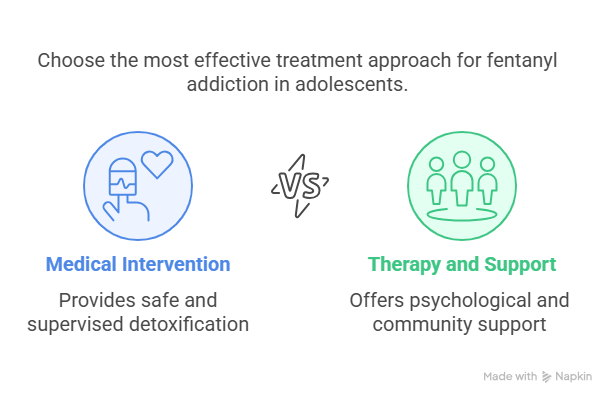As a parent, there’s nothing more concerning than suspecting fentanyl abuse in your child. The opioid crisis has escalated, making it crucial for parents to be aware of the potential dangers. Fentanyl, a highly potent opioid, can be lethal even in small doses, making it essential to recognize the warning signs early.
Fentanyl abuse among youngsters is a growing concern, and being informed is the first step towards ensuring their safety. By understanding the indicators of fentanyl use, parents can take proactive measures to protect their children.
Key Takeaways
- Recognizing the signs of fentanyl abuse in children is crucial for their safety.
- Fentanyl is a highly potent opioid that can be lethal in small doses.
- Parents must be aware of the potential dangers and take proactive measures.
- Early detection can save lives.
- Staying informed is key to protecting children from fentanyl abuse.
The Fentanyl Threat to American Youth
American youth are facing an unprecedented threat from fentanyl, a powerful synthetic opioid that is 50 to 100 times more potent than morphine. The rise in fentanyl-related overdose deaths among adolescents has become a critical concern.
Fentanyl is often mixed with other drugs, making it difficult for users to know what they are consuming, thereby increasing the risk of overdose. Parents and caregivers need to be aware of the warning signs of fentanyl use, which can include unusual drowsiness, constricted pupils, and changes in behavior.
The threat is real and requires immediate attention and action to protect the youth.
Signs Your Child Is Using Fentanyl: What Parents Need to Know
Fentanyl use among adolescents is a growing concern, and recognizing the signs is the first step towards helping your child. Parents need to be aware of the symptoms of fentanyl use in young people to intervene early and effectively.
1. Unusual Drowsiness or Sedation
One of the common signs of fentanyl use is unusual drowsiness or sedation. If your child is excessively sleepy or lethargic, it could be a sign of fentanyl use. Monitor their behavior and consult a healthcare professional if you notice persistent drowsiness.
2. Constricted Pupils and Facial Itching
Fentanyl use can cause constricted pupils and facial itching. If you notice your child’s pupils are smaller than usual or they are frequently scratching their face, it may indicate fentanyl use. These symptoms should be taken seriously and discussed with a medical professional.
3. Respiratory Issues or Shallow Breathing
Respiratory issues or shallow breathing are critical signs of fentanyl overdose. Fentanyl can slow down breathing rates, which can be life-threatening. If your child is experiencing difficulty breathing, seek immediate medical attention.
4. Sudden Mood Swings and Irritability
Fentanyl use can lead to sudden mood swings and irritability. If your child becomes easily agitated or exhibits unpredictable behavior, it could be a sign of fentanyl addiction. Monitoring their mood and behavior is crucial.
5. Declining School Performance and Attendance
A decline in school performance and attendance can be an indicator of fentanyl use. If your child starts to show less interest in school or their grades begin to slip, it may be related to fentanyl use.
6. Unexplained Financial Problems or Missing Valuables
Unexplained financial problems or missing valuables from your home could be a sign that your child is using fentanyl. They may be seeking money to purchase the drug, leading to financial issues or theft.
7. Discovery of Unfamiliar Pills, Powders, or Paraphernalia
Finding unfamiliar pills, powders, or paraphernalia is a direct indicator of potential fentanyl use. Be vigilant about your child’s belongings and surroundings to identify any suspicious items.
8. Changes in Friend Groups and Social Activities
A change in friend groups or social activities can be a sign of fentanyl use. If your child starts associating with new friends or becomes withdrawn from their usual social circle, it may indicate involvement with fentanyl.
9. Increased Secrecy and Isolation
Increased secrecy and isolation are common behaviors among individuals using fentanyl. If your child becomes more secretive or isolates themselves from family and friends, it could be a sign of fentanyl addiction.
10. Signs of Withdrawal When Unable to Use
Experiencing withdrawal symptoms when unable to use fentanyl is a significant indicator of addiction. Symptoms can include nausea, sweating, and agitation. If your child exhibits these symptoms, seek professional help immediately.
Understanding the Difference Between Experimentation and Addiction
The line between experimenting with fentanyl and being addicted can be blurry, causing concern for many parents. Experimentation might involve a single use or occasional use of fentanyl, often driven by curiosity or peer pressure. In contrast, addiction is characterized by compulsive drug-seeking behavior despite negative consequences. Detecting fentanyl use in adolescents early on can help prevent the transition from experimentation to addiction.
Fentanyl abuse in children can start innocently but quickly spiral out of control. Understanding these differences is key to addressing the issue effectively.
| Characteristics | Experimentation | Addiction |
|---|---|---|
| Frequency of Use | Occasional | Frequent |
| Reason for Use | Curiosity, Peer Pressure | Compulsive Need |
| Impact on Life | Minimal Initially | Significant Negative Impact |
How to Approach Your Child If You Suspect Fentanyl Use
When you suspect your child is using fentanyl, your approach can significantly impact their willingness to open up about the issue. It’s essential to create an environment where your child feels safe and supported.
Creating a Safe Space for Honest Communication
To encourage honest communication, choose the right time and place for the conversation, ensuring privacy and minimal distractions. Listen actively to what they say, avoiding interruptions and showing empathy through your expressions and body language.
Avoiding Accusations and Judgment
Avoid making accusatory statements or displaying judgmental behavior, as this can lead to defensiveness and further secrecy. Instead, express your concerns about their well-being and safety, focusing on the specific behaviors that have raised your suspicions.
| DO | DON’T |
|---|---|
| Listen actively | Interrupt or dismiss their feelings |
| Express concern for their safety | Make accusatory statements |
| Choose the right time and place | Rush the conversation |
Treatment Options for Fentanyl Use in Adolescents
For adolescents battling fentanyl use, a tailored treatment approach can make a significant difference. Treating fentanyl addiction in young people requires a comprehensive strategy that addresses both the physical and psychological aspects of addiction.
Medical Intervention and Detox Programs
Medical intervention is often the first step in treating fentanyl addiction. Detox programs help manage withdrawal symptoms, making it easier for adolescents to stop using fentanyl. These programs are typically supervised by healthcare professionals to ensure safety and comfort.
Therapy and Support Groups
Therapy and support groups play a crucial role in the recovery process. Behavioral therapies, such as cognitive-behavioral therapy (CBT), help adolescents understand and change their drug-use behaviors. Support groups provide a sense of community and understanding, which is vital for long-term recovery.

Prevention Strategies for Parents
Preventing fentanyl use in adolescents requires a proactive approach. Parents can play a significant role in safeguarding their children by adopting effective prevention strategies.
Open Dialogue About Drug Dangers
Engaging in open and honest conversations with your child about the dangers of fentanyl is crucial. This dialogue can help your child understand the risks associated with fentanyl use and make informed decisions. Creating a safe and non-judgmental space for discussion encourages your child to be more forthcoming about their experiences or concerns.
Open Dialogue About Drug Dangers
Discussing the risks of fentanyl use, such as overdose and addiction, can deter children from experimenting with the drug. It’s essential to provide factual information and avoid using scare tactics, which can be counterproductive.
Monitoring Without Invading Privacy
Finding a balance between monitoring your child’s activities and respecting their privacy is vital. Implementing reasonable supervision without being overly intrusive can help you stay informed about your child’s behavior while maintaining a healthy relationship.
Conclusion
Understanding the signs your child is using fentanyl is crucial in addressing the issue promptly. By being aware of the warning signs of fentanyl use in teens, parents can take the first step towards helping their child.
Early recognition and open communication can significantly impact the effectiveness of the intervention. By creating a safe and non-judgmental space, parents can encourage their child to open up about their struggles.
Seeking professional help and exploring treatment options can provide the necessary support for adolescents struggling with fentanyl use. With the right approach, it’s possible to guide your child towards a healthier and safer path.
FAQ
What are the common signs of fentanyl use in children?
Common signs include unusual drowsiness, constricted pupils, respiratory issues, sudden mood swings, declining school performance, unexplained financial problems, discovery of unfamiliar substances, changes in friend groups, increased secrecy, and signs of withdrawal.
How can I tell if my child is experimenting with fentanyl or is addicted?
Experimentation may involve occasional use, while addiction is characterized by compulsive use despite negative consequences. Look for signs of physical dependence, such as withdrawal symptoms, and assess the impact on their daily life.
What should I do if I suspect my child is using fentanyl?
Approach your child in a non-accusatory manner, creating a safe space for honest communication. Avoid judgment and focus on expressing concern for their well-being.
What are the available treatment options for adolescents struggling with fentanyl use?
Treatment options include medical intervention and detox programs, as well as therapy and support groups. These help adolescents overcome physical dependence and address underlying issues.
How can I prevent my child from using fentanyl?
Prevention strategies include maintaining an open dialogue about drug dangers and monitoring your child’s activities without invading their privacy. This helps them make informed decisions and reduces the risk of fentanyl use.
What are the risks associated with fentanyl use in adolescents?
Fentanyl use poses significant risks, including overdose, respiratory depression, and long-term health consequences. It’s essential for parents to be aware of these risks and take proactive steps to protect their children.
Can fentanyl addiction be treated in adolescents?
Yes, fentanyl addiction can be treated in adolescents with the right approach. Treatment typically involves a combination of medical intervention, therapy, and support groups, tailored to the individual’s needs.
How can I support my child if they are struggling with fentanyl addiction?
Supporting a child with fentanyl addiction requires empathy, understanding, and patience. Encourage them to seek professional help and offer ongoing support throughout the recovery process.
Reference




